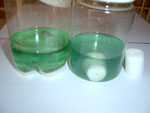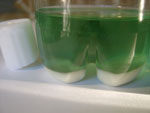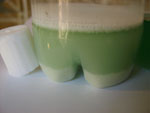| Open wax structure of fuel iFleet fuel catalyst - Improves Cloud Point (catalyst dissolving candle wax, petroleum by product)
iFleet fuel catalyst is capable of opening the solid wax structure. This has a positive impact on viscosity and filter life efficiency. It is also a direct indication of the product's capability of opening the hydrocarbon chain inside fossil fuels, thereby enhancing the oxidisation process. This proves the principles of the World Patent. The opening of the wax structure allows improved oxidation of the fuel, which results in improved burn capabilities during the combustion process. Technical Theory on Unsaturated Hydrocarbons. Because the hydrocarbons differ in boiling points, they can be separated into a number of fractions for different uses. The lightest fractions (containing one or two carbon atoms) constitute natural gas and as such are used without further purification. The next higher hydrocarbons (three & four carbon atoms) may be used for bottled gas for cooking and heating. The larger range of hydrocarbons, which boil between 40 and 180°C, consisting of more than a hundred different compounds varying in carbon content from 6 to 12 carbon atoms per molecule, constitute various qualities of gasoline. The best hydrocarbon for use in an internal combustion engine contains eight carbon atoms per molecule (octane). Furthermore, if the hydrocarbon chain is "branched" it produces a more complete burn and hence has better anti- knock qualities. The introduction of a long unbranched saturated hydrocarbon could achieve the same effect without the undesirable emissions. It was crucial that the chosen elements be oil barrel derivatives and compatible with all forms of saturated hydrocarbon fuel. The fraction of petroleum which boils above 180°C is used as kerosene, diesel and furnace fuel. From this fraction also comes jet fuel. At this temperature these fuels are fully liquid. However, at cooler temperatures it is noted that there is a tendency towards reformation of the fatty waxes from which the fuel is formed. With the introduction of the long unbranched saturated hydrocarbon, we were able to interface with the unsaturated hydrocarbon and open the structure to a more desirable and more liquid diesel form. This has great advantage insofar that, whilst passing through injectors, the fuel forms a better spray pattern and the force required to drive such is reduced. A further advantage is of course that the fuel will burn more completely as the molecule size is greatly reduced. By so doing, less unburnt residue would be released through the exhaust. A further advantage is realized on filter replacement periods. As the structure is now smaller, the filter does not need to address mass coagulation of wax on the surface. Diesel fuel, which has been in storage for any length of time, loses much of its potential because of the grouping of these molecules. This invention will not allow this grouping to occur. |
Copyright iFLEET© 2007
Site design by G-spot









 Benefits:
Benefits: